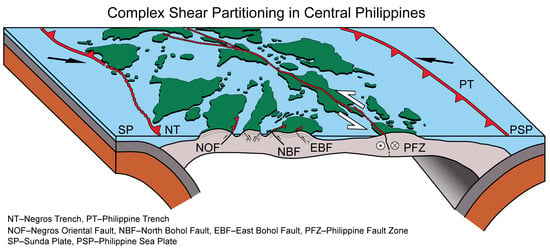Complex Shear Partitioning Involving the 6 February 2012 MW 6.7 Negros Earthquake Ground Rupture in Central Philippines
Abstract
:1. Introduction
2. Tectonic Setting
3. Ground Rupture Mapping
3.1. Rupture Trace
3.2. Scarp Heights
3.3. Scarp Morphologies
4. Discussion
5. Conclusions
Supplementary Materials
Author Contributions
Funding
Acknowledgments
Conflicts of Interest
References
- Philippine Institute of Volcanology and Seismology (PHIVOLCS). Latest Earthquake Information. Available online: http://earthquake.phivolcs.dost.gov.ph (accessed on 6 February 2012).
- Wells, D.L.; Coppersmith, K.J. New empirical relationships among magnitude, rupture length, rupture width, rupture area, and surface displacement. Bull. Seism. Soc. Am. 1994, 84, 974–1002. [Google Scholar]
- Rimando, J.; Aurelio, M.; Dianala, J.D.; Taguibao, K.J.; Agustin, K.M.; Berador, A.E.; Vazquez, A. Coseismic ground rupture of the October 15, 2013 Magnitude (Mw) 7.2 Bohol Earthquake, Bohol Island, Central Philippines. Tectonics 2019, 38, 2558–2580. [Google Scholar] [CrossRef]
- Fitch, T.J. Plate convergence, transcurrent faults, and internal deformation adjacent to Southeast Asia and the western Pacific. J. Geophys. Res. 1972, 77, 4432–4460. [Google Scholar] [CrossRef]
- Barrier, E.; Huchon, P.; Aurelio, M. Philippine fault: A key for Philippine kinematics. Geology 1991, 19, 32–35. [Google Scholar] [CrossRef]
- Aurelio, M.A. Tectonics of the Philippines Revisited. J. Geol. Soc. Philipp. 2000, 55, 119–183. [Google Scholar]
- Aurelio, M.A. Shear partitioning in the Philippines: Constraints from Philippine Fault and global positioning system data. Isl. Arc 2000, 9, 584–597. [Google Scholar] [CrossRef]
- Aurelio, M.A.; Dianala, J.D.B.; Taguibao, K.J.L.; Pastoriza, L.R.; Reyes, K.; Sarande, R.; Lucero, A., Jr. Seismotectonics of the 6 February 2012 Mw 6.7 Negros Earthquake, central Philippines. J. Asian Earth Sci. 2017, 142, 93–108. [Google Scholar] [CrossRef]
- Hamilton, W. Tectonics of the Indonesian Region: U. S. Geological Survey Professional Paper 1078; U.S. Government Printing Office: Washington, DC, USA, 1979; p. 345.
- Acharya, H.K.; Aggarwal, Y.P. Seismicity and tectonics of the Philippine Islands. J. Geophys. Res. 1980, 85, 3239–3250. [Google Scholar] [CrossRef]
- Bautista, B.C.B.; Bautista, M.L.P.; Oike, K.; Wu, F.T.; Punongbayan, R.S. A new insight on the geometry of subducting slabs in northern Luzon, Philippines. Tectonophysics 2001, 339, 279–310. [Google Scholar] [CrossRef]
- Cardwell, R.K.; Isacks, B.L.; Karig, D.E. The spatial distribution of earthquakes, focal mechanism solutions and subducted lithosphere in the Philippines and northern Indonesian regions. In The Tectonic and Geologic Evolution of Southeast Asian Seas and Islands: American Geophysical Union Monograph; Hayes, D., Ed.; American Geophysical Union: Washington, DC, USA, 1980; Volume 23, pp. 1–35. [Google Scholar]
- Hamburger, M.W.; Cardwell, R.K.; Isacks, B. Seismotectonics of the northern Philippine arc. In The Tectonic and Geologic Evolution of Southeast Asian Seas and Islands: Part 2; American Geophysical Union Geophysical Monograph: Washington, DC, USA, 1983; Volume 27, pp. 1–22. [Google Scholar]
- Hayes, D.E.; Lewis, S.D. Structure and tectonics of the Manila trench system, Western Luzon, Philippines. Energy 1985, 10, 263–279. [Google Scholar] [CrossRef]
- Allen, C.R. Circum-Pacific faulting in the Philippines-Taiwan Region. J. Geophys. Res. Space Phys. 1962, 67, 4795–4812. [Google Scholar] [CrossRef] [Green Version]
- Bischke, R.E.; Suppe, J.; del Pilar, R. A new branch of the Philippine fault system as observed from aeromagnetic and seismic data. Tectonophysics 1990, 183, 243–264. [Google Scholar] [CrossRef]
- Ringenbach, J.C.; Pinet, N.; Stephan, J.F. Structural variety and tectonic evolution of strike-slip basins related to the Philippine fault system, northern Luzon, Philippines. Tectonics 1993, 12, 187–203. [Google Scholar] [CrossRef]
- Nakata, T.; Tsutsumi, H.; Punongbayan, R.S.; Rimando, R.E.; Daligdig, J.; Daag, A. Surface faulting associated with the Philippine Earthquake of 1990. J. Geogr. 1990, 99, 515–532. [Google Scholar] [CrossRef] [Green Version]
- Rimando, R.E.; Rimando, J.M. Morphotectonic Kinematic Indicators along the Vigan-Aggao Fault: The Western Deformation Front of the Philippine Fault Zone in Northern Luzon, the Philippines. Geosciences 2020, 10, 83. [Google Scholar] [CrossRef] [Green Version]
- Pubellier, M.; Deffontaines, B.; Rangin, C. Drainage network analysis and tectonics of Mindanao, southern Philippines. Geomorphology 1994, 9, 325–342. [Google Scholar]
- Quebral, R.D.; Rangin, C.; Pubellier, M. The onset of movement on the Philippine Fault in eastern Mindanao: A transition from a collision to a strike-slip environment. Tectonics 1996, 15, 713–726. [Google Scholar] [CrossRef]
- Tsutsumi, H.; Perez, J.S. Large-scale active fault map of the Philippine fault based on aerial photograph interpretation. Act. Fault Res. 2013, 2013, 29–37. [Google Scholar]
- Rangin, C.; Muller, C.; Porth, H. Neogene geodynamic evolution of the Visayan Region, in On the Geology and Hydrocarbon Prospects of the Visayan Basin, Philippines. In Geologisches Jahrbuch. Reihe B, Regionale Geologie Ausland 70; Porth, H., Daniels, C.H., Eds.; University of California: Berkeley, CA, USA, 1989; pp. 7–28. [Google Scholar]
- Aurelio, M.A.; Peña, R.E. (Eds.) Geology of the Philippines. In Tectonics and Stratigraphy, 2nd ed.; Mines and Geosciences Bureau, Department of Environment and Natural Resources: Quezon City, Philippines, 2010; Volume 1. [Google Scholar]
- Letouzey, J.; Muller, C.; Pelletier, B.; Rangin, C.; Stephan, J.F. Middle Miocene (NN5), a Main Kinematic Reorganization period for the South. China Sea Region; Abstract—5th reg. Congr. On the Geology; Mineral and Energy Resources of SE Asia—GEOSEA V: Kuala Lumpur, Malaysia, 1984. [Google Scholar]
- Yu, S.-B.; Hsu, Y.J.; Bacolcol, T.; Yang, C.C.; Tsai, Y.C.; Solidum, R. Present-day crustal deformation along the Philippine Fault in Luzon, Philippines. J. Asian Earth Sci. 2013, 65, 64–74. [Google Scholar] [CrossRef]
- Abigania, M.I.T.; Arpa, M.C.; Beliran, J.; Bornas, M.A.; Cahulogan, M.; Catane, S.; Daag, A.; Decierdo, P.D.; Del Monte, L.R.; Garcia, F.; et al. Geologic Impacts of the 06 February 2012 Negros Oriental Earthquake in Negros Oriental and Cebu QRT Report of Investigation Conducted on 7–27 February 2012; Internal Report; PHIVOLCS: Quezon City, Philippines, 2012; p. 50. [Google Scholar]
- Daag, A.; Bacolcol, T.; Nakata, T.; Cahulogan, M.; Abigania, M.I.; Rivera, D.; Villahermosa, R.L.; Deposoy, C.; Ramos, J.E. Sub-Aerial and Sub-Marine Landslides Triggered by the February 6, 2012 Negros Oriental Earthquake: Assessment and Implications. In Proceedings of the GEOCON2012 –XXV Annual Geological Convention, Makati City, Philippines, 6 February 2012; p. 32. [Google Scholar]
- Daag, A.; Abigania, M.I.T.; Cahulogan, M.; Garcia, F.; Jorgio, R.; Mangao, E.A.; Punongbayan, B.J.T.; Pagtalunan, M.; Lamela, R.; Decierdo, P.D.; et al. 06 February 2012 Negros Oriental Earthquake: Geologic Impacts of the 06 February 2012 Negros Oriental Earthquake in Negros Oriental and Cebu; Report of Investigation; PHIVOLCS: Quezon City, Philippines, 2015; p. 52. Available online: https://www.phivolcs.dost.gov.ph/index.php/publications/special-report (accessed on 1 September 2020).
- Paringit, E.C.; Otadoy, R.S. LiDAR Surveys and Flood Mapping of Tanjay River; University of the Philippines Training Center for Applied Geodesy and Photogrammetry: Quezon City, Philippines, 2017; p. 155. [Google Scholar]
- Shuwen, D.; Yueqiao, Z.; Zhenhan, W.; Nong, Y.; Yinsheng, M.A.; Wei, S.; Zhengle, C.; Changxing, L.; Meijian, A. Surface Rupture and Co-seismic Displacement Produced by the Ms 8.0 Wenchuan Earthquake of May 12th, 2008, Sichuan, China: Eastwards Growth of the Qinghai-Tibet Plateau. Acta Geol. Sin. Engl. Ed. 2008, 82, 938–948. [Google Scholar] [CrossRef]
- Liu-Zeng, J.; Zhang, Z.; Wen, L.; Tapponnier, P.; Sun, J.; Xing, X.; Hu, G.; Xu, Q.; Zeng, L.; Ding, L.; et al. Co-seismic ruptures of the 12 May 2008, Ms 8.0 Wenchuan earthquake, Sichuan: East–west crustal shortening on oblique, parallel thrusts along the eastern edge of Tibet. Earth Planet. Sci. Lett. 2009, 286, 355–370. [Google Scholar] [CrossRef]
- Xu, X.; Wen, X.; Yu, G.; Chen, G.; Klinger, Y.; Hubbard, J.; Shaw, J. Coseismic reverse and oblique-slip surface faulting generated by the 2008 Mw 7.9 Wenchuan earthquake, China. Geology 2009, 37, 515–518. [Google Scholar] [CrossRef]
- Li, Y.; Huang, R.; Yan, L.; Densmore, A.L.; Zhou, R. Surface Rupture and Hazard of Wenchuan Ms 8.0 Earthquake, Sichuan, China. Int. J. Geosci. 2010, 1, 21–31. [Google Scholar] [CrossRef] [Green Version]
- Ren, J.; Chen, G.; Xu, X.; Zhang, S.; Mao, C. Surface Rupture of the 2008 Wenchuan, China, Earthquake in the Qingping Stepover Determined from Geomorphologic Surveying and Excavation, and Its Tectonic Implications. Bull. Seism. Soc. Am. 2010, 100, 2651–2659. [Google Scholar] [CrossRef] [Green Version]
- Fu, B.; Shi, P.; Guo, H.; Okuyama, S.; Ninomiya, Y.; Wright, S. Surface deformation related to the 2008 Wenchuan earthquake, and mountain building of the Longmen Shan, eastern Tibetan Plateau. J. Asian Earth Sci. 2011, 40, 805–824. [Google Scholar] [CrossRef]
- Tan, X.; Yuan, R.-M.; Xu, X.-W.; Chen, G.-H.; Klinger, Y.; Chang, C.-P.; Ren, J.; Xu, C.; Li, K. Complex surface rupturing and related formation mechanisms in the Xiaoyudong area for the 2008 Mw 7.9 Wenchuan Earthquake, China. J. Asian Earth Sci. 2012, 58, 132–142. [Google Scholar] [CrossRef]
- Kaneda, H.; Nakata, T.; Tsutsumi, H.; Kondo, H.; Sugito, N.; Awata, Y.; Akhtar, S.S.; Majid, A.; Khattak, W.; Awan, A.A.; et al. Surface Rupture of the 2005 Kashmir, Pakistan, Earthquake and Its Active Tectonic Implications. Bull. Seism. Soc. Am. 2008, 98, 521–557. [Google Scholar] [CrossRef]
- Chen, Y.-G. Surface Rupture of 1999 Chi-Chi Earthquake Yields Insights on Active Tectonics of Central Taiwan. Bull. Seism. Soc. Am. 2004, 91, 977–985. [Google Scholar] [CrossRef]
- Lin, A.; Ouchi, T.; Chen, A.; Maruyama, T. Co-seismic displacements, folding and shortening structures along the Chelungpu surface rupture zone occurred during the 1999 Chi-Chi (Taiwan) earthquake. Tectonophysics 2001, 330, 225–244. [Google Scholar] [CrossRef]
- Dziewonski, A.M.; Chou, T.-A.; Woodhouse, J.H. Determination of earthquake source parameters from waveform data for studies of global and regional seismicity. J. Geophys. Res. Space Phys. 1981, 86, 2825–2852. [Google Scholar] [CrossRef]
- Ekstrom, G.; Nettles, M.; Dziewoński, A. The global CMT project 2004–2010: Centroid-moment tensors for 13,017 earthquakes. Phys. Earth Planet. Inter. 2012, 1–9. [Google Scholar] [CrossRef]
- Rimando, R.E.; Lim, R.B.; Garduque, R.J.; Rimando, J.M. Ground Rupture of the February 6, 2012 M6.9 Negros Earthquake; Geological Society of the Philippines: Makati City, Philippines, 2013; p. 1. [Google Scholar]
- Olson, S.M.; Green, R.A.; Lasley, S.; Martin, N.; Cox, B.R.; Rathje, E.; Bachhuber, J.; French, J. Documenting Liquefaction and Lateral Spreading Triggered by the 12 January 2010 Haiti Earthquake. Earthq. Spectra 2011, 27, S93–S116. [Google Scholar] [CrossRef] [Green Version]
- Philip, H.; Rogozhin, E.; Cisternas, A.; Bousquet, J.C.; Borisov, B.; Karakhanian, A. The Armenian earthquake of 1988 December 7: Faulting and folding, neotectonics and palaeoseismicity. Geophys. J. Int. 1992, 110, 141–158. [Google Scholar] [CrossRef] [Green Version]
- Yu, G.; Xu, X.; Klinger, Y.; Diao, G.; Chen, G.; Feng, X.; Li, C.; Zhu, A.; Yuan, R.; Guo, T.; et al. Fault-Scarp Features and Cascading-Rupture Model for the Mw 7.9 Wenchuan Earthquake, Eastern Tibetan Plateau, China. Bull. Seism. Soc. Am. 2010, 100, 2590–2614. [Google Scholar] [CrossRef] [Green Version]
- Lin, A.; Ren, Z.; Jia, D.; Wu, X. Co-seismic thrusting rupture and slip distribution produced by the 2008 Mw 7.9 Wenchuan earthquake, China. Tectonophys 2009, 471, 203–215. [Google Scholar] [CrossRef]
- Boncio, P.; Liberi, F.; Caldarella, M.; Nurminen, F.-C. Width of surface rupture zone for thrust earthquakes: Implications for earthquake fault zoning. Nat. Hazards Earth Syst. Sci. 2018, 18, 241–256. [Google Scholar] [CrossRef] [Green Version]
- Rimando, R.E.; Punongbayan, R.S.; Catane, S.G.; Mirabueno, H.T.; Rasdas, A.S. Ground Rupture of the 15 November 1994 Oriental Mindoro (Philippines) Earthquake. In Proceedings of the XXI General Assembly of IUGG, Boulder, CO, USA, 2–14 July 1995; p. A422. [Google Scholar]
- Haeussler, P.J.; Schwartz, D.P.; Dawson, T.E.; Stenner, H.D.; Lienkaemper, J.J.; Sherrod, B.; Cinta, F.R.; Montone, P.; Craw, P.A.; Crone, A.J.; et al. Surface rupture and slip distribution of the Denali and Totschunda faults in the 3 November 2002 M 7.9 earthquake, Alaska. Bull. Seismol. Soc. Am. 2004, 94, S23–S52. [Google Scholar] [CrossRef]
- Bowman, D.; King, G.; Tapponnier, P. Partitioning by elastoplastic slip propagation of oblique depth. Science 2003, 300, 1121–1123. [Google Scholar] [CrossRef]
- McCaffrey, R. Oblique plate convergence, slip vectors, and forearc deformation. J. Geophys. Res. 1992, 97, 8905–8915. [Google Scholar] [CrossRef]
- Jones, C.H.; Wesnousky, S.G. Variations in strength and slip rate along the San Andreas fault system. Science 1992, 256, 83–86. [Google Scholar] [CrossRef]
- Yu, G.; Wesnousky, S.G.; Ekström, G. Slip partitioning along major convergent plate boundaries. In Shallow Subduction Zones: Seismicity, Mechanics and Seismic Potential Part 1; Dmowska, R., Ekström, G., Eds.; Springer: Basel, Switzerland, 1993; pp. 183–210. [Google Scholar]
- Bautista, B.C. Seismotectonic Implications of Recent Philippine Earthquakes from 1980–1994. Master’s Thesis, State University of New York at Binghamton, Binghamton, NY, USA, 1996; p. 218. [Google Scholar]
- Rimando, R.E. Neotectonic and Paleoseismic Study of the Marikina Valley Fault System, Philippines. Ph.D. Thesis, State University of New York at Binghamton, Binghamton, NY, USA, 2002; p. 232. [Google Scholar]
- Rimando, R.E.; Knuepfer, P.L. Neotectonics of the Marikina Valley fault system (MVFS) and tectonic framework of structures in northern and central Luzon, Philippines. Tectonophysics 2006, 415, 17–38. [Google Scholar] [CrossRef]
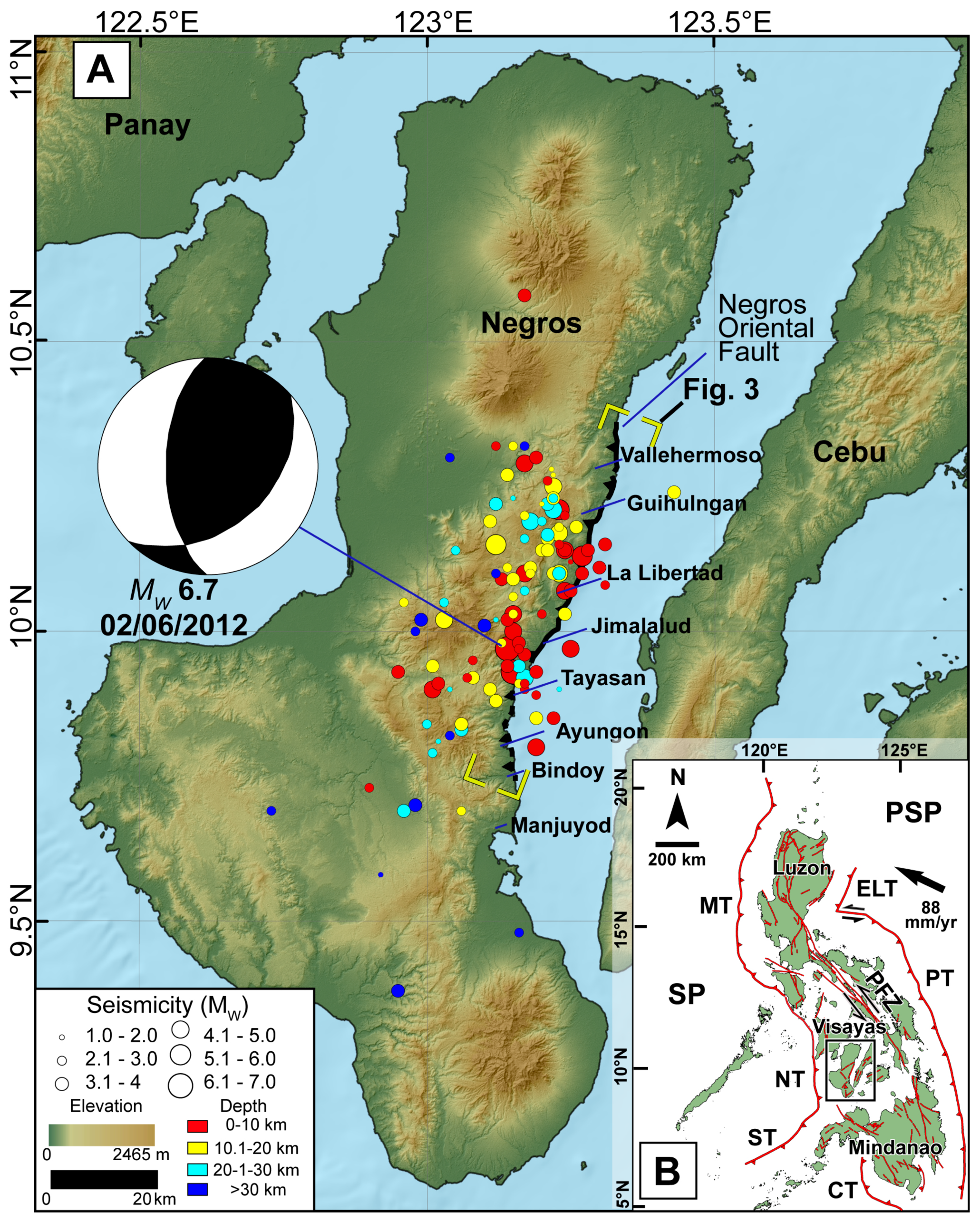
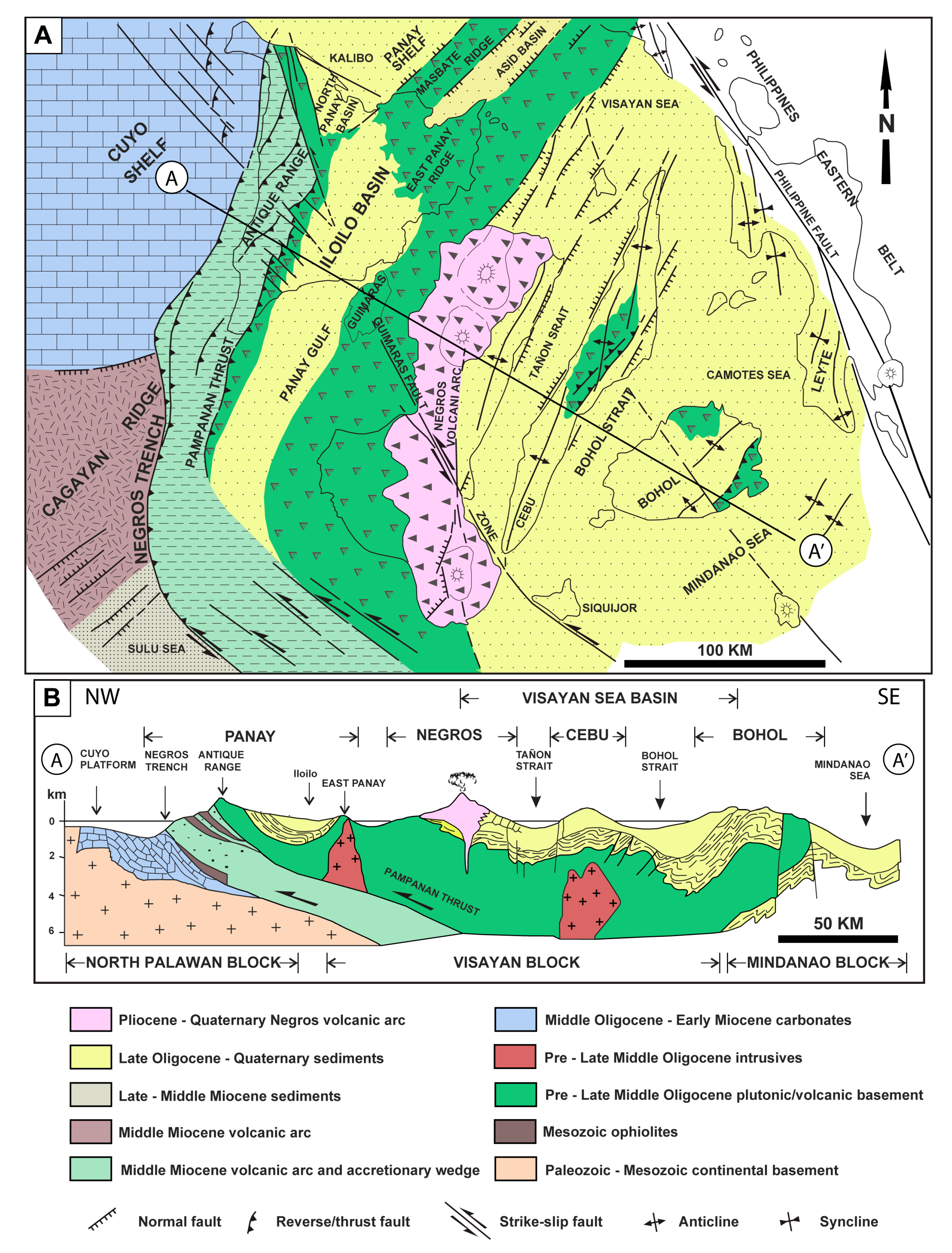
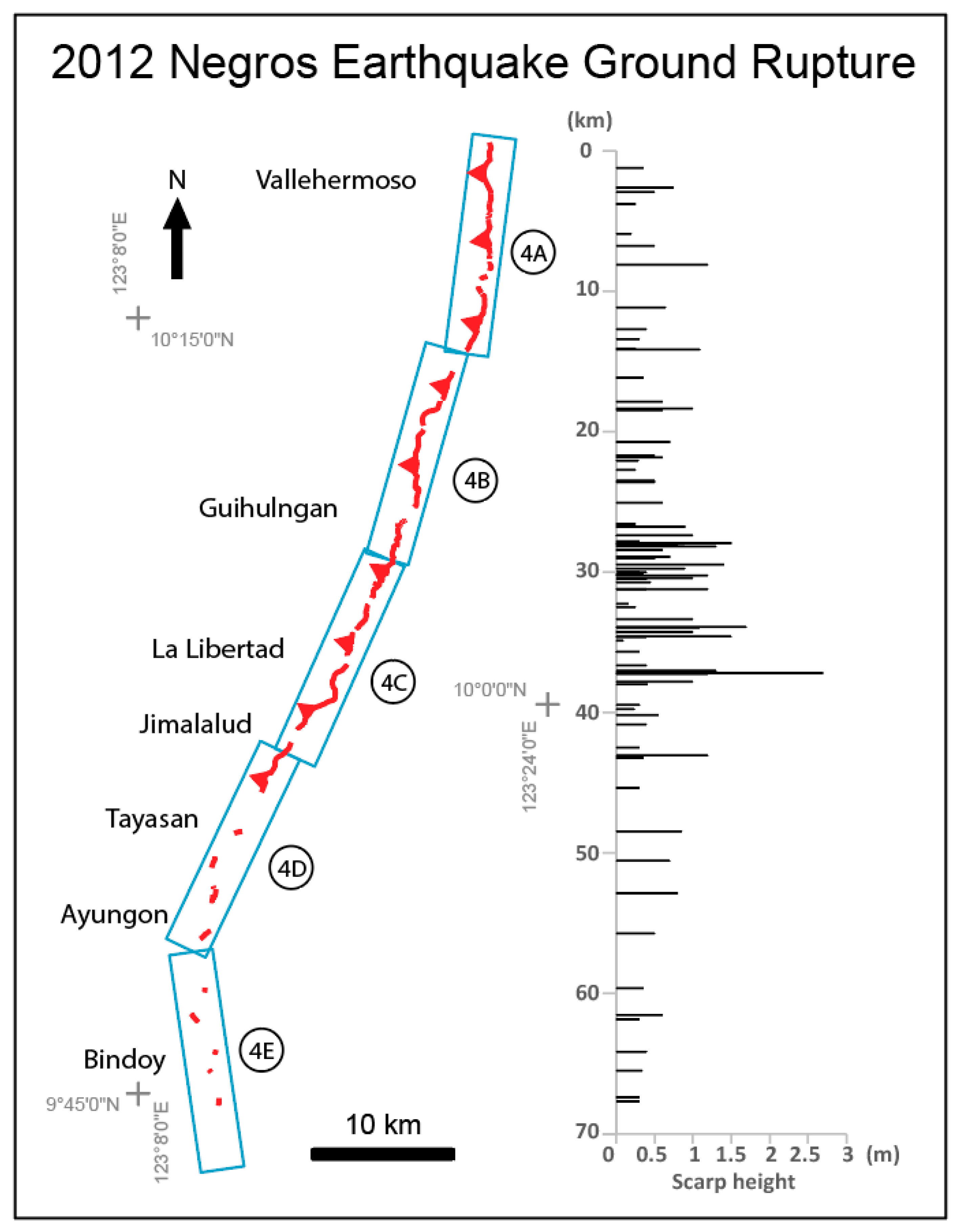


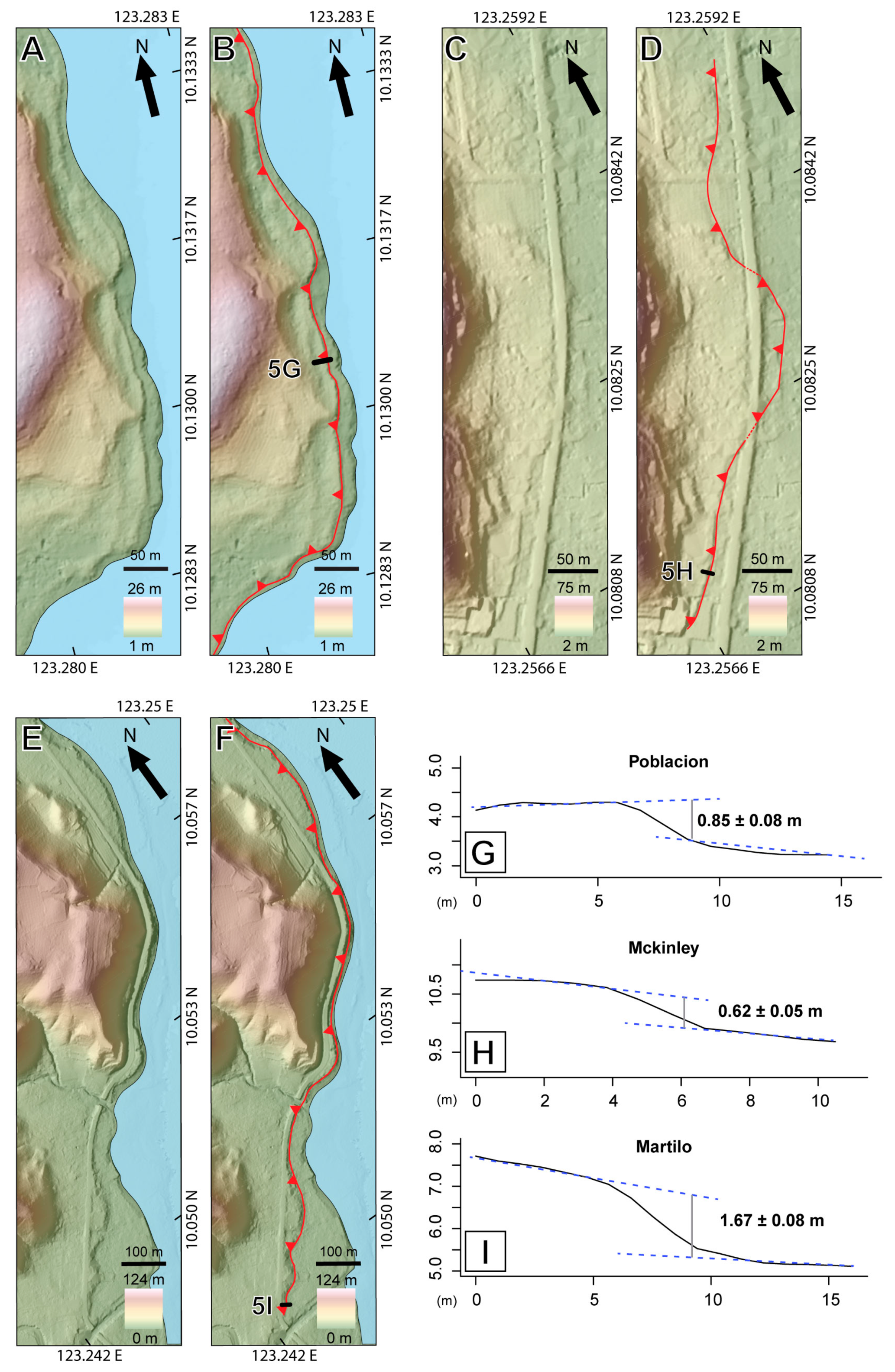
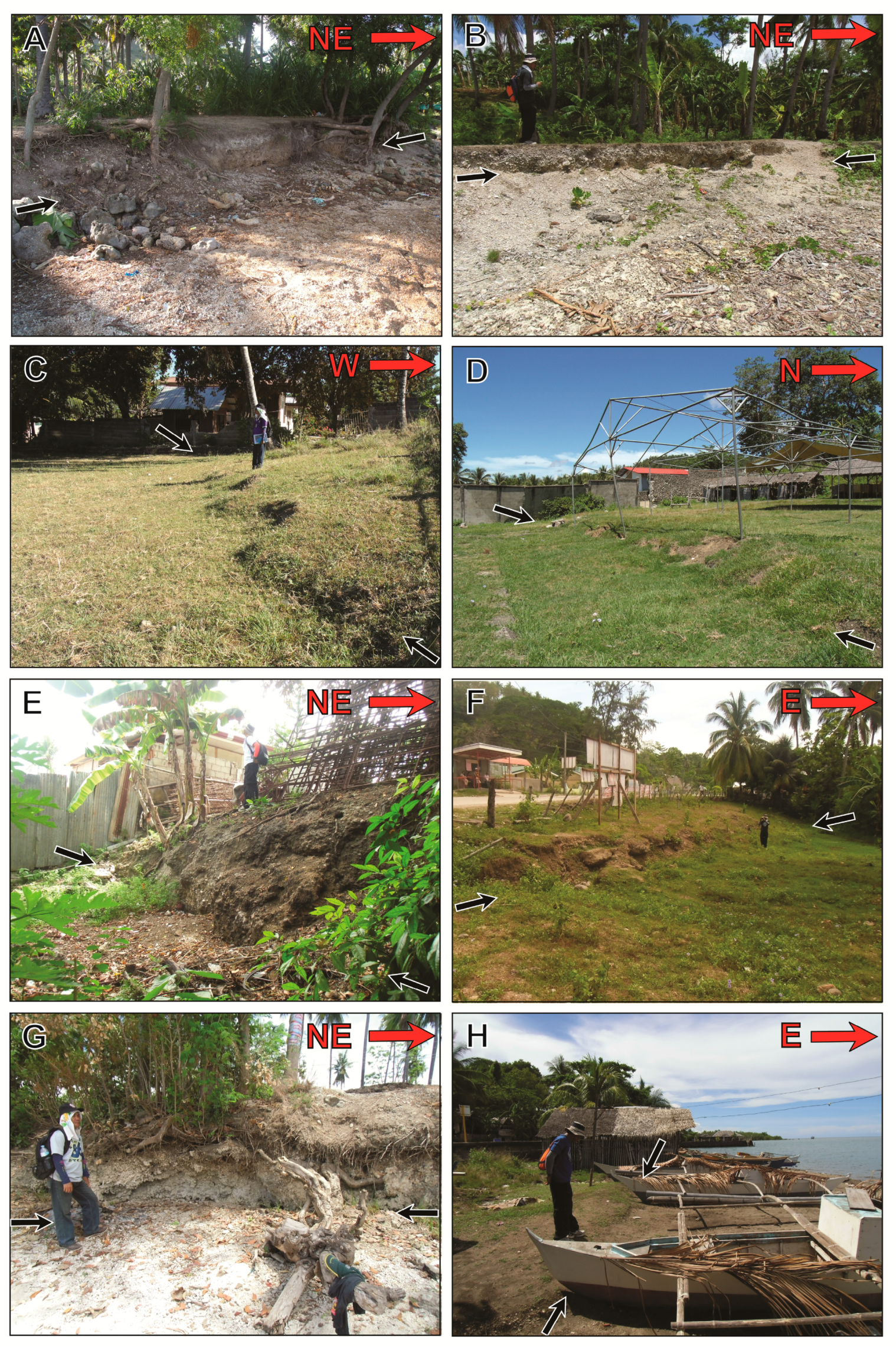
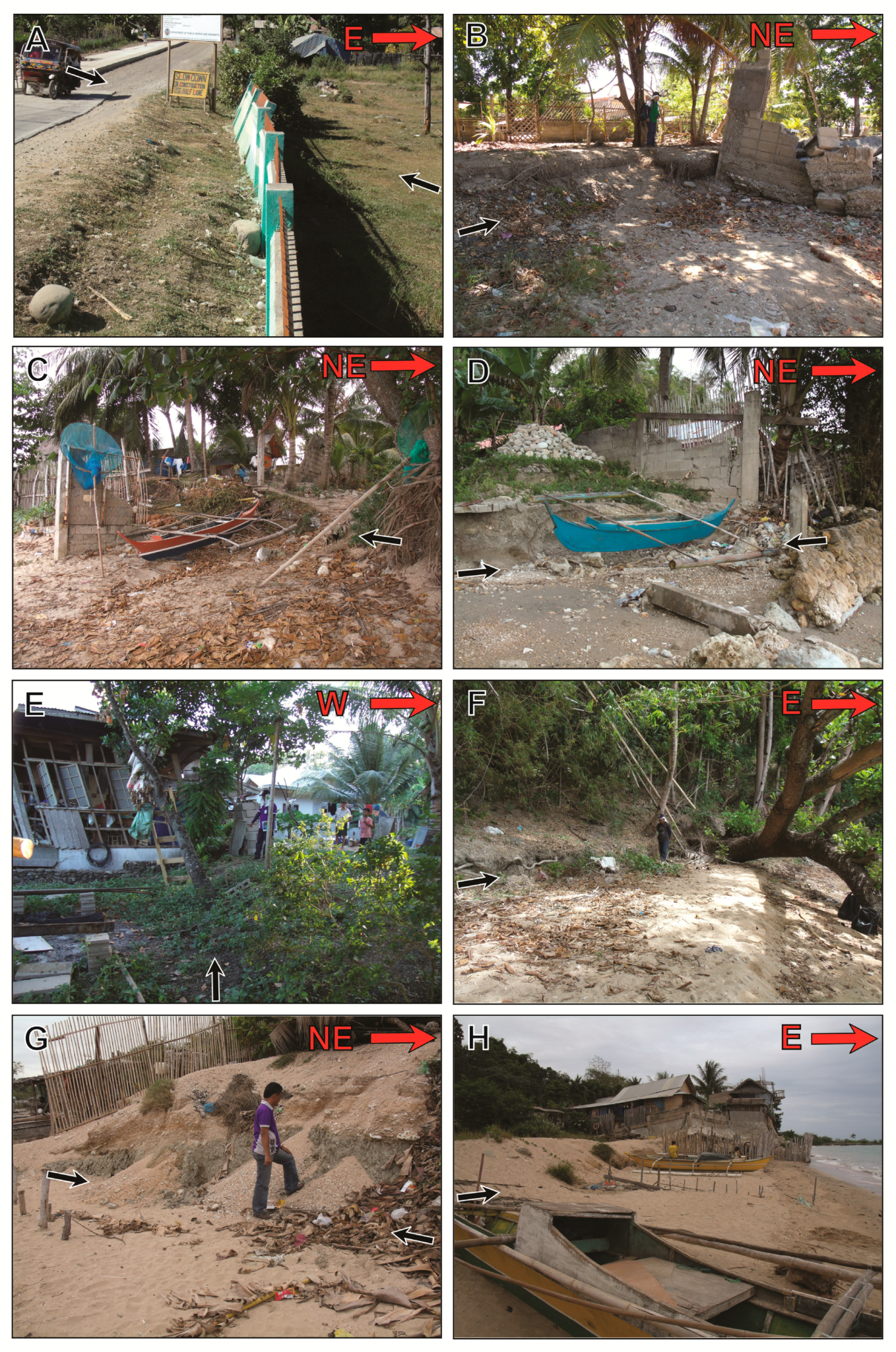
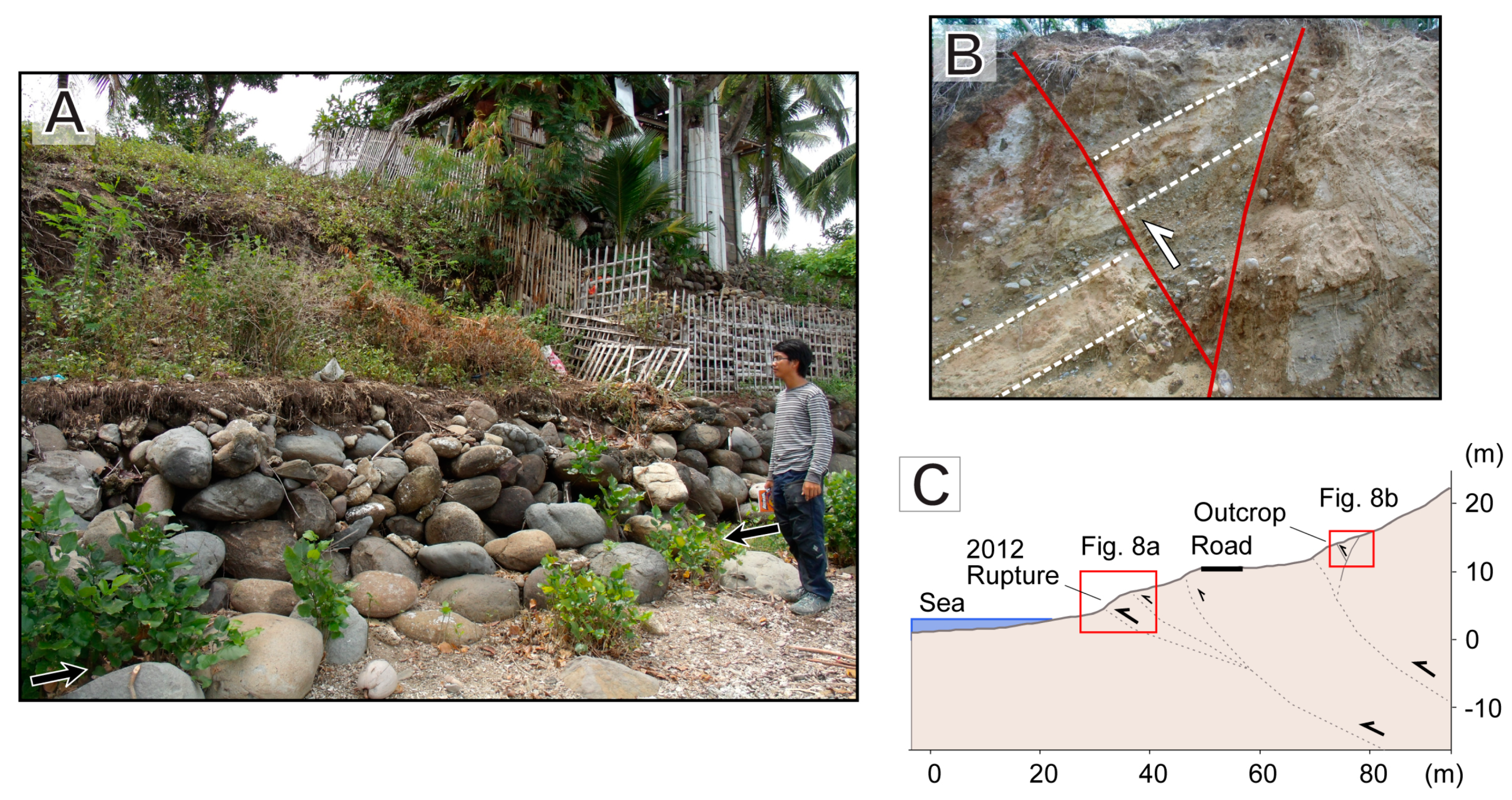
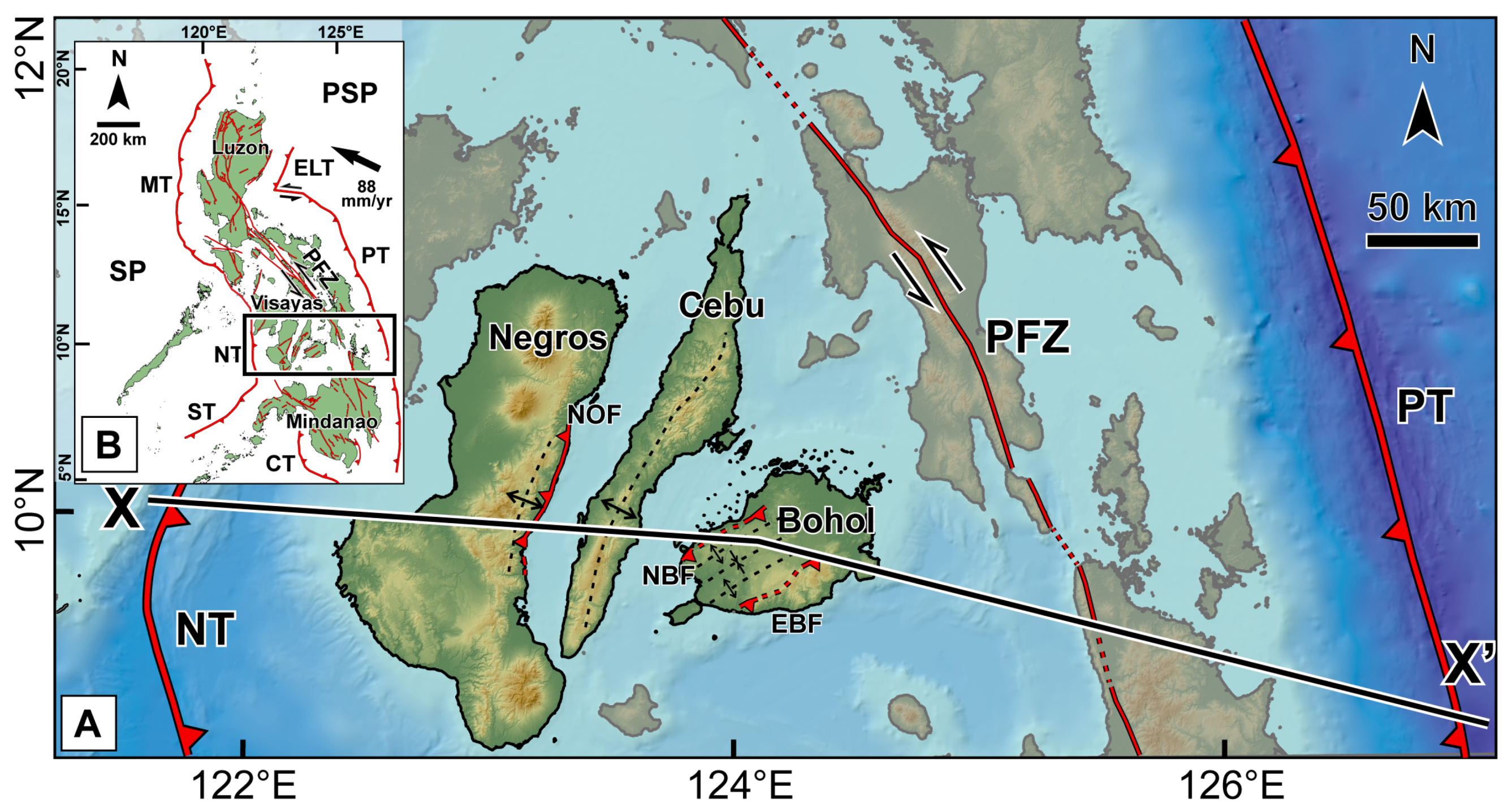
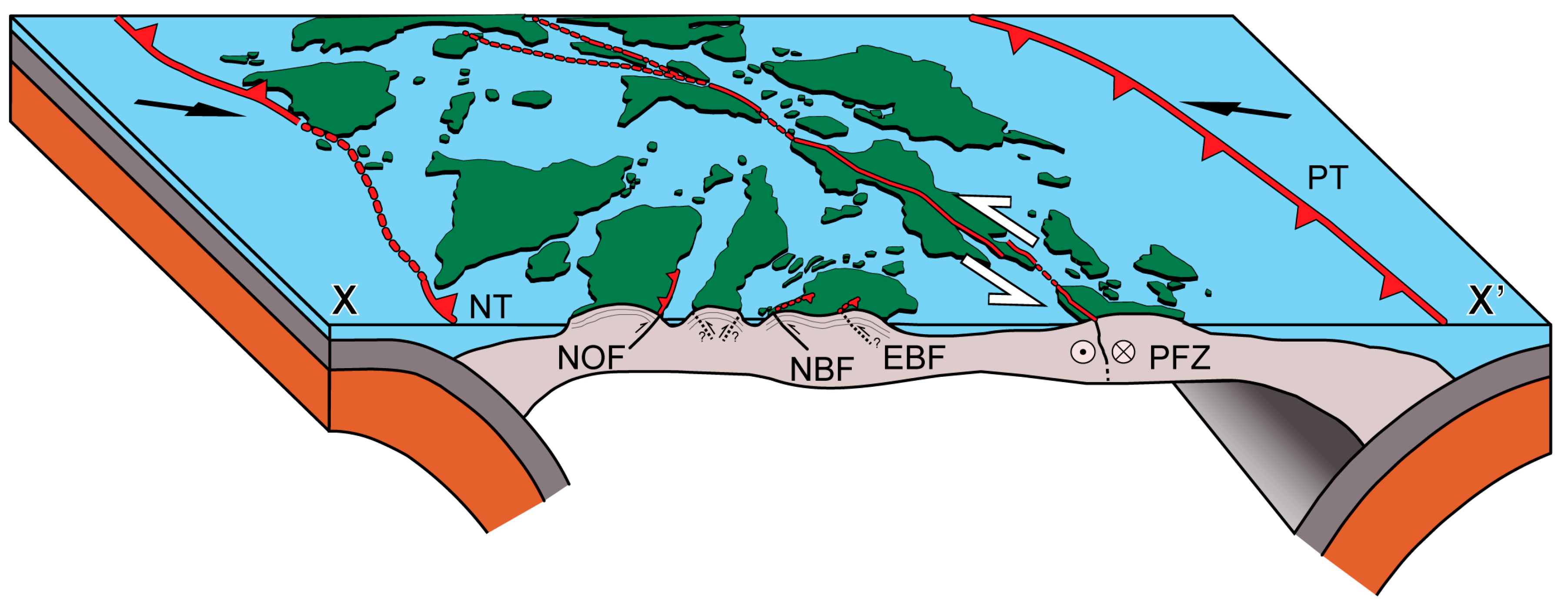
Publisher’s Note: MDPI stays neutral with regard to jurisdictional claims in published maps and institutional affiliations. |
© 2020 by the authors. Licensee MDPI, Basel, Switzerland. This article is an open access article distributed under the terms and conditions of the Creative Commons Attribution (CC BY) license (http://creativecommons.org/licenses/by/4.0/).
Share and Cite
Rimando, R.E.; Rimando, J.M.; Lim, R.B. Complex Shear Partitioning Involving the 6 February 2012 MW 6.7 Negros Earthquake Ground Rupture in Central Philippines. Geosciences 2020, 10, 460. https://doi.org/10.3390/geosciences10110460
Rimando RE, Rimando JM, Lim RB. Complex Shear Partitioning Involving the 6 February 2012 MW 6.7 Negros Earthquake Ground Rupture in Central Philippines. Geosciences. 2020; 10(11):460. https://doi.org/10.3390/geosciences10110460
Chicago/Turabian StyleRimando, Rolly E., Jeremy M. Rimando, and Robjunelieaaa B. Lim. 2020. "Complex Shear Partitioning Involving the 6 February 2012 MW 6.7 Negros Earthquake Ground Rupture in Central Philippines" Geosciences 10, no. 11: 460. https://doi.org/10.3390/geosciences10110460
APA StyleRimando, R. E., Rimando, J. M., & Lim, R. B. (2020). Complex Shear Partitioning Involving the 6 February 2012 MW 6.7 Negros Earthquake Ground Rupture in Central Philippines. Geosciences, 10(11), 460. https://doi.org/10.3390/geosciences10110460





